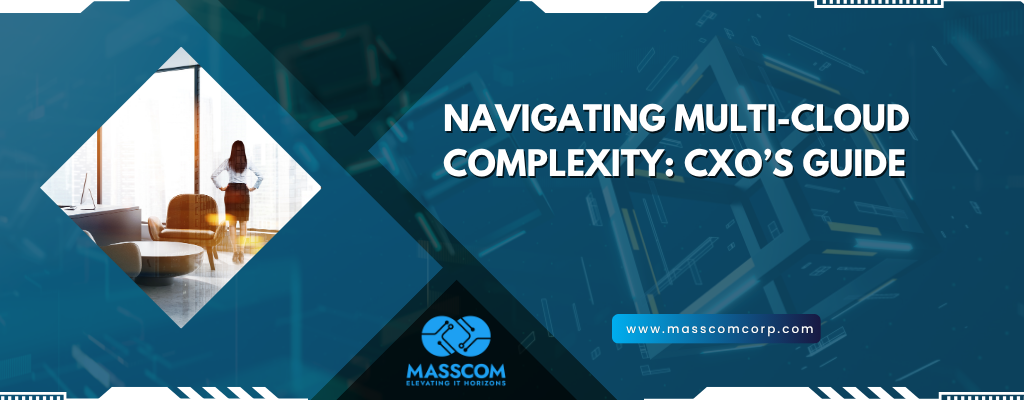As enterprises increasingly embrace multi-cloud strategies, the promise of agility, innovation, and resilience is often shadowed by growing complexity, ballooning costs, and fragmented governance. For C-level executives, particularly CIOs, CTOs, and CFOs, navigating this environment requires a strategic balance of flexibility and control.
We provide a comprehensive guide for CXOs to tackle the operational and financial challenges of managing multi-cloud ecosystems. We’ll explore proven frameworks for governance, cost optimization, and ROI-focused cloud management.
The Rise of Multi-Cloud: Opportunity Meets Complexity
Modern enterprises adopt multi-cloud environments to:
- Avoid vendor lock-in
- Leverage best-in-class services across cloud providers like AWS, Azure, GCP, etc.
- Ensure high availability and disaster recovery
However, this diversification leads to:
- Inconsistent security policies
- Redundant resource allocation
- Fragmented visibility into cloud spend
- Compliance risk and governance silos
Without a unified strategy, the multi-cloud advantage can quickly turn into an operational liability.
Top Challenges in Multi-Cloud Management for CXOs
1. Lack of Centralized Governance
Each cloud provider offers its own set of management tools, naming conventions, access policies, and billing formats. This creates silos in security, compliance, and visibility—especially in large, distributed teams.
2. Uncontrolled Cloud Spend
Costs often spiral due to:
- Idle or overprovisioned resources
- Shadow IT (unauthorized deployments)
- Disconnected budgeting from actual usage
- Lack of real-time visibility into resource consumption
3. Compliance and Risk Management
Different regions and sectors demand different data residency, encryption, and audit standards. Managing these across providers becomes exponentially harder.
4. Skill Gaps and Tool Sprawl
Each cloud requires unique skills. Teams end up juggling multiple tools for billing, provisioning, monitoring, and security, hurting productivity and increasing human error.
Framework for CXOs: Establishing Centralized Governance
To simplify multi-cloud operations, CXOs should implement a Cloud Governance Framework that aligns with business goals. Key pillars include:
1. Policy Standardization
Define organization-wide cloud usage policies
- Set clear guidelines on tagging, provisioning, and resource ownership
- Use infrastructure-as-code (IaC) to enforce consistency
2. Identity and Access Management (IAM)
Centralized authentication with SSO and RBAC
- Integrate identity governance tools (e.g., Okta, Azure AD)
- Audit user permissions regularly
Lets discuss your next project
3. Compliance Monitoring
Use automated tools to map cloud deployments to frameworks like GDPR, HIPAA, or ISO 27001
- Schedule periodic audits across all providers
- Create a compliance dashboard for real-time alerts
Cost Optimization: Turning Visibility into Value
1. Achieve Cost Transparency:
Standardize tags and metadata for all resources
- Use cost allocation reports segmented by business unit, team, or application
- Implement chargeback/showback models for accountability
2. Automate Cost Controls
Set up auto-scaling and rightsizing recommendations
- Identify unused or underutilized resources
- Schedule non-production workloads to shut down during off-hours
3. Use Cloud Management Platforms (CMPs)
Modern CMPs such as CloudHealth by VMware, Flexera, Spot by NetApp, or Azure
Cost Management offer:
- Unified dashboards across providers
- Cost forecasting and anomaly detection
- Policy-driven governance
- Performance optimization recommendations
A Strategic CXO Playbook for Multi-Cloud ROI
Here’s a practical roadmap to ensure your multi-cloud investments deliver business value:
Phase Focus Area CXO Actions
| Phase | Focus Area | CXO Actions |
|---|---|---|
| Assess | Inventory & Visibility | Conduct full asset discovery, tag all resources |
| Align | Governance | Define and enforce organization-wide policies |
| Optimize | Cost & Usage | Identify waste, automate savings |
| Empower | Teams & Tools | Upskill teams, consolidate tools |
| Monitor | KPIs & ROI | Track performance vs. cost and adjust strategies |
Key Metrics CXOs Should Monitor
To measure governance maturity and cost-effectiveness, track:
- % of resources with proper tagging
- Cost per app/team/project vs. budget
- Number of compliance violations/month
- Cloud savings from automation initiatives
- Cloud ROI (Business value delivered vs. total spend)
Multi-cloud isn’t just an IT strategy; it’s a business decision. Without centralized governance and cost visibility, even the best cloud investments can underperform or become financial burdens.
CXOs must lead with clarity, discipline, and agility—building scalable governance frameworks, enforcing financial accountability, and continuously aligning cloud operations with business value.
The goal isn’t to control every workload but to enable innovation at scale, with visibility and confidence.
Ready to simplify your multi-cloud environment and drive cost savings? Let us connect!


